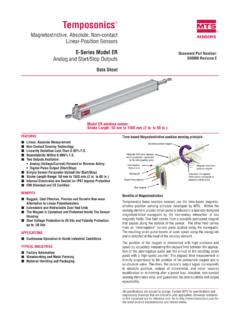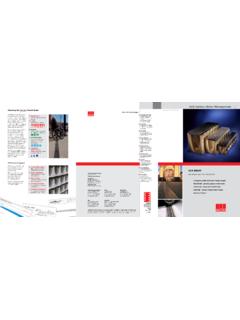Transcription of ACQUITY UPLC Sample Manager - Flow Through …
1 ACQUITY UPLCS ample Manager - Flow Through Needle Operator s overview and Maintenance InformationRevision CCopyright Waters Corporation 2010 2011 All rights reservediiCopyright notice 2010 2011 WATERS CORPORATION. PRINTED IN THE UNITED STATES OF AMERICA AND IN IRELAND. ALL RIGHTS RESERVED. THIS DOCUMENT OR PARTS THEREOF MAY NOT BE REPRODUCED IN ANY FORM WITHOUT THE WRITTEN PERMISSION OF THE information in this document is subject to change without notice and should not be construed as a commitment by Waters Corporation. Waters Corporation assumes no responsibility for any errors that may appear in this document. This document is believed to be complete and accurate at the time of publication. In no event shall Waters Corporation be liable for incidental or consequential damages in connection with, or arising from, its of ContentsiiiCopyright notice.
2 IiOverview .. 1 Location of SM-FTN in the ACQUITY UPLC system .. 1 Flow path Through the Sample management 2 SM-FTN major components .. 3 Functional systems .. 6 Injection mechanics .. 7 Preparing for operation .. 10 Installing the leak sensor .. 11 Installing the waste tubing .. 13 Calibrating the needle s z axis .. 15 Priming the SM-FTN .. 15 Using the SM-FTN .. 17 Interface requirements .. 17 Installation recommendations for 18 Selecting purge and wash solvents .. 20 Washing the SM-FTN needle .. 22 Loading Sample plates .. 22 Sample chamber considerations .. 26 Choosing needles and extension loops .. 26 Choosing the Sample 29 Choosing the Sample syringe draw rate .. 30 Choosing the needle height 31 Recovering maximum Sample from 32 Revising a plate type.
3 33 Air gaps .. 33 Load-ahead and loop offline options .. 34 Auto additions .. 38 Auto dilution .. 38 Diagnostic tests .. 38 Resolving leak sensor errors .. 39 Table of ContentsivTable of ContentsMaintaining the SM-FTN .. 43 Contacting Waters technical 43 Maintenance schedule .. 44 Maintenance 45 Configuring maintenance warnings .. 46 Replacing the leak 46 Replacing the seal .. 48 Replacing the Sample needle and needle 61 Replacing the Sample syringe .. 69 Cleaning the injection port .. 72 Replacing the injection valve cartridge .. 75 Cleaning the instrument s 77 Overview1 OverviewYou can submit samples for analysis on the ACQUITY UPLC system by loading microtiter plates or vials onto the rotary Sample tray of the Sample Manager -Flow Through Needle (SM-FTN).
4 Using a flow- Through -needle mechanism, in which the needle is part of the high-pressure Sample flow path, the Sample Manager injects the samples it draws from the plates and vials onto a chromatographic column. Optional extension loops (installed between the Sample needle and the injection valve) increase the volume of your injections beyond that of the Sample needle. Using the SM-FTN, you also can dilute injected samples (auto-dilution).Location of SM-FTN in the ACQUITY UPLC systemThe following diagram shows the location of the SM-FTN in the ACQUITY UPLC trayDetectorColumn heaterSample Manager - Flow Through NeedleSolvent manager2 Tips: Use care when stacking or moving the SM-FTN. Ensure the drip tray does not collide with any surface. Use care when installing and removing reusable also: Column Compartments Operator's overview and Maintenance Information on the ACQUITY UPLC System Documentation CD to avoid potential leaks or path Through the Sample management systemThe following diagram shows how the SM-FTN functions as part of the ACQUITY UPLC from column heaterWash solvent direct from solvent bottleSampleDegassed solvent from solvent managerInject valveMobile phase from solvent managerTo c o l u m nSecondary drainage to solvent managerSecondary drainage to solvent managerPrimary drainage to solvent managerPrimary drainage to solvent managerSample syringe valveOverview3SM-FTN major componentsThe following diagrams show the SM-FTN s major view with doors closed.
5 On/off switchPower LEDRun LEDS ample compartment doorFluidics compartment door4 Front view, with doors open:Plate selector switchSample syringeLocation of Sample Manager leak sensorInjection valveSample trayChamber temperature sensorAccess panelSample syringe valveLocation of back pressure regulatorLocation of column heater leak sensorOverview5 Sample compartment components visible with access panel removed:SM-FTN components:ComponentDescriptionAccess panelRemovable panel (requires a TORX driver) that allows access to Sample compartment components such as the seal assembly and needle lightingLED that illuminates the Sample compartment. The compartment light automatically turns on when the SM-FTN s Sample compartment door is opened and turns off when the door is closed. The light can also be turned off via the console to accommodate light-sensitive portAn assembly that houses the injection port, needle seal, needle wash mechanism, and force of Sample needleInjection/wash portInjection port wash drainSample needle carriageLocation of wash tubeCompartment lightingLocation of column heater leak sensor cable connectorLocation of Sample Manager leak sensor cable connector6 Functional systemsR positioning mechanismThe R (R-theta) positioning mechanism s two axes control the orientation of the Sample plates within the Sample compartment and the relative position of the Sample needle carriage.
6 The theta-rotary axis is a belt-driven shaft that rotates a pair of Sample plates 360 from a reference point. The R-linear axis is the axis along which the Sample needle carriage is oriented. The carriage runs from the rear-left corner to the front-right corner of the Sample port wash drainDirects the needle wash to valveA two-position, six-port injection sensorContinuously monitors the SM-FTN for leaks and stops the system flow when its optical sensor detects about mL of accumulated, leaked liquid in its surrounding selector switch Toggle switch used to select either plate position 1 or syringeDraws Sample into the Sample syringe valveA three-position, rotary-shear needleExtracts Sample from needle carriagePositions the Sample needle in the Sample traySecures the Sample plates or vial holders in temperature sensorLocated on the upper guide rail toward the back of the Sample chamber.
7 To monitor Sample tubeDelivers wash solvent to the inject/wash components: (Continued)ComponentDescriptionOverview7 Injection systemThe injection flow path includes the assemblies required to aspirate a Sample and deliver it to the column. The process involves the needle, optional extension loop, Sample syringe and syringe valve, injection valve, and injection/wash path diagram:Injection mechanicsDuring an needle is positioned and driven down by the PEEK support sleeve prevents buckling and helps ensure proper alignment with the valveWash pumpInOutWash solventPurge solventSampleTo wasteSample syringePressure transducerTo wasteUnionInject valve inject positionFrom solvent managerTo columnInjection portSample needle is driven into the seat to a specified force to form the first high-pressure second high-pressure seal on the seat is formed during assembly when the seat is locked into place between the support sleeve and overflow cup via a compression entire injection port assembly rests on a spring and is guided in an aluminum needle presses against the seat, compressing the spring.
8 Which creates the required load between the needle and the of injection needle and seal:The following figures show a standard ACQUITY UPLC system cycle time and load-ahead cycle sealNeedle motionSealLocation of Force sensorSpring cupAluminum housingOverflow cupForce applied Through the needle carriageNEEDLEN eedleSealOverview9 Standard ACQUITY UPLC system cycle time definition:Wash systemThe wash system cleans the outside of the Sample needle while it is inside the injection/wash can choose two external needle washes, pre-injection or post-injection. Neither wash sequence allows wash solvent to enter the Sample (insertion) washThe pre-injection wash washes the needle at a location above the seal position used for injection. The solvent begins to flow before the needle is lowered to this wash to perform this wash if you are concerned about material on the outside of the Sample needle damaging the seal or affecting the contact between the seal and the (OD needle) washPerformed by default, this wash washes the exterior of the Sample needle after an injection is made and the needle remains in the seal Sample preparationand positioningSample injectionSystemsetupStandard injection modeTotal ACQUITY UPLC system cycle timeChromatographic run timePre-washPost-wash10 Two priming modes are available: Wash solvent prime, where the wash solvent flows Through the wash system to prime each component.
9 Purge solvent prime, where the degassed purge solvent flows Through the Sample purge solvent used for priming is also the solvent used to move Sample Through the injection flow path. During auto-dilution, the purge solvent is the dilution systemThe thermal system maintains the set temperature in the Sample : You do not need to defrost the Sample compartment. The SM-FTN s fans stop circulating air whenever the Sample compartment door is open. The Sample tray rotates slowly when the system is idle, to help maintain a uniform temperature across the for operationNote: The system is shipped with a 15- L needle. If you are not using the default ACQUITY UPLC system configuration, which uses this needle, see page you prepare the SM-FTN for operation, prepare the solvent : For instructions on preparing the solvent Manager , see ACQUITY UPLC Quaternary Solvent Manager Operator s overview and Maintenance Information or ACQUITY UPLC Binary Solvent Manager Operator s overview and Maintenance of the SM-FTN involves these steps: Installing the leak sensor Installing the waste tubing Calibrating the rotary Sample tray Priming the SM-FTNP reparing for operation11 Installing the leak sensorRequired materials Gloves: clean, powder-free, chemical-resistant Leak sensorTo install the leak the the fluidics compartment unpack the new leak.
10 To avoid the harmful effects of personal contact with solvents, including inhalation, observe Good Laboratory Practice when you handle them. See the Material Safety Data Sheets for the solvents you : To avoid personal contamination with biologically hazardous or toxic materials, wear clean, chemical-resistant, powder-free gloves when performing this : To avoid damaging electrical parts, never disconnect an electrical assembly while power is applied to an instrument. To completely interrupt power, set the power switch to Off, and then unplug the power cord from the AC source. Wait 10 seconds thereafter before you disconnect an the leak sensor s T-bar with the slot in the side of the leak sensor reservoir, and slide the leak sensor into the leak sensor connector into the front of the the the ACQUITY UPLC Console, select Sample Manager FTN from the system the SM-FTN information window, click Control > Reset SM, to reset the sensor installed in reservoirSlot in leak sensor reservoirPreparing for operation13 Installing the waste tubingRequired materialGloves: clean, powder-free, chemical-resistantTo install the waste the pre-installed, corrugated tubing running from the process waste port (found on the lower drip tray of the Sample Manager ), and Caution.



